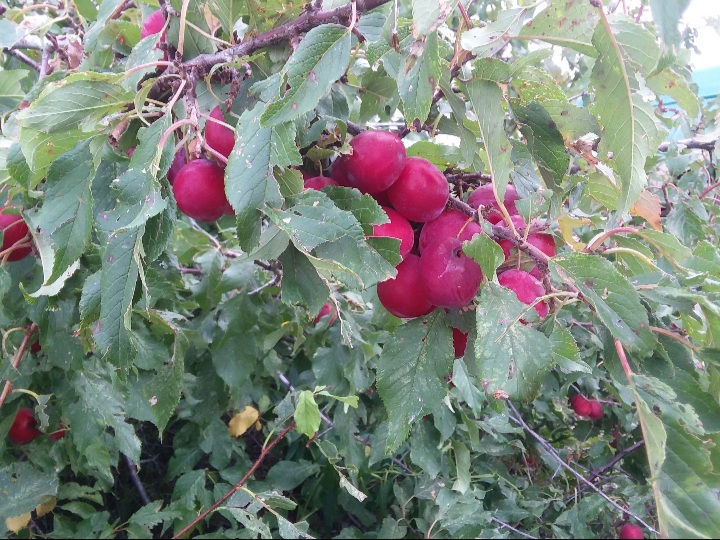Around Abbys Table - Water Bath Canning

Description: The Water Bath Canning Process is Used To Preserve A Variety of Fruits and Food Products from Tomato Sauce to Wild Sandhill Plum Jelly. This Picture is From a Southeast Colorado Patch of Sandhill Plums that Made Great Jelly...
Around Abby's Table
Water Bath Canning
There are two methods for home canning fruits and veggies. I am going to go over how to water bath can fruits. Vegetables need to be processed in a pressure caner, not by water bathing. Fruits, pie fillings, pickles, salsa, and jams/jellies are preserved by the water bath method. I am going to give very basic instructions. Processing times very on conditions such as: fruit you are preserving, size of jar, elevation, etc. I recommend you read a Ball home canning book for specific processing times for your recipe.
It is important to follow all of the steps and make sure you get a seal on your lids. If it is not done correctly you risk food spoilage and botulism. Botulism: is a rare and potentially fatal illness caused by a toxin produced by the bacterium Clostridium botulinum. If you ever question if your home canned food (or store bought for that matter) has spoiled, throw it away.
What you will need:
-
I highly suggest a Ball home canning book. These have answers to many of your questions. Often called the Ball Bible.
-
A water bath canner (a big stock pot w/lid will work)
-
Jars
-
Rings and seals (lids)
-
Jar grabber
-
Magnetite lid grabber
-
Food funnel
-
Ladle
-
Something to let the air out of filled jars (I use a butter knife)
-
Clean towels
-
Most recipes call for lemon juice and/or salt
-
Your recipe
Once we get moving it will go quickly. The jars and food will be hot, because this is a hot pack. So, make sure you have all your supplies and tools ready to use. Also, keep little ones in mind if they are under foot while you work. For me this was a good time to teach both my daughter and son the value of “putting up” our own winter food storage. Sandhill plum jelly taste like an August morning in the middle of February.
Steps:
-
Wash your hands! Wash your hands! Wash your hands!
-
Sterilize all of your supplies (In your dishwasher if it has a sterilize cycle. Or, by boiling them at a rolling boil for fifteen minutes.)
-
Heating your jars is important not just for cleanliness, but also to have them at the same temp as the mixture you will be filling them with. If you fill a cold jar with hot food it may crack. This is a good time to check to make sure your jars and lids (rings and seals) are in usable condition. Don't use jars that are cracked or chipped. Don't use seals that are old and worn out.
-
Prepare your recipe.
-
Place hot mixture in hot jar. Making sure to leave ¼ inch room from the top of the jar.
-
This is where salt and/or lemon juice is added. Not all recipes call for this step.
-
Use the butter knife to release any air bubbles.
-
Wipe mouth and sides of jar. This is to remove any spilled food.
-
Place the seal on the jar and screw ring on.
-
Place full jars into water bath. Water should cover the tops of jars by at least an inch.
-
Wait for water to become a rolling boil.
-
Set timer for length of time your recipe calls for, or follow the chart in the Ball home canning book.
-
Remove jars from water bath.
-
Set in a draft free place.
-
You should hear a suck pop sound as lids seal. Check lids for seal in the morning, you can do this by pressing on the center of the lid. If it pops up and down, you do not have a seal.
-
Enjoy the fruits of your labor!
If you do not get a proper seal, you have to repeat the processing steps. Or, you can just start on that jar of jelly. I will also give those jars away first. I tell my loved ones, the jar didn't seal, so use it, and refrigerate what is left.
If you have any questions a long the way consult you Ball Bible, ask someone who is experienced with home canning, I spent hours on the phone with my Grandma New when I first started learning to make pear sauce. You may also want to see if your local library or extension office offers any classes on home canning. Both have useful information and can be very helpful to you.
Follow SECO News on Facebook.
Subscribe to the SECO News YouTube Channel.





.png)






.png)
.png)


.png)







